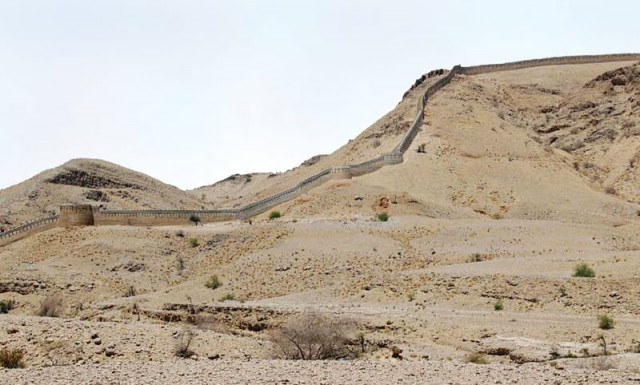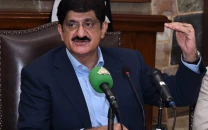History and conservation: Mending a fort whose makers left no traces of themselves
The Endowment Fund Trust repairs Ranikot whose origins are still a mystery

History and conservation: Mending a fort whose makers left no traces of themselves
The anthropologist in Nafisa Shah is itching. "There's nothing to defend here," she asks everyone and no one in particular as the bus full of conservators and architects enters the rocky womb of a valley holding Ranikot Fort in Jamshoro. Nafisa is echoing explorer Isobel Shaw's words: "The size of Ranikot defies all reason. It stands in the middle of nowhere, defending nothing."
The mystery of this 32km structure is on everyone's minds as the Endowment Fund Trust tour begins this Saturday. The trust has organised the visit as it has wrapped up some repairs that began in January and cost Rs2 million. The trust's chairman, financier Jahangir Siddiqui, has flown in by helicopter to welcome the students and experts who have come to learn about it. "This is the beginning," he says, referring to the work. "And hopefully it will continue for years."
It is likely to take years and considerable sums of money to restore this unbelievable historic site but the trust's team is not short on spirit. "It's been a dream to do something here," says Hamid Akhund, the trust's secretary. Ranikot is, after all, believed to be the largest fort in the world and has been on the tentative list of Unesco World Heritage Sites since 1993.
The adjective 'large' doesn't, however, do justice to the sheer scale of Ranikot. Its walls run like lacework, topping the crests of ridges - Karo Takkar on the western boundary and the Lundi Hills on the eastern. The sinuous rills of the mustard hills are scored horizontally as if someone ran their fingers through their hair. At dusk, they recede into lilac hues. All sense of scale is subverted; you cannot configure yourself in this landscape as a tiny human. The eye runs along the ribbon of the fort and telescopes out to the backdrop. You feel as if you are falling into yourself because of the surrounding expanse. Even the weeping needle leaves of the salt cedar trees at the bottom of the hills seem to be saying something.
Everyone in the group is struggling to describe what they are experiencing but perhaps Nafisa Shah ends up saying it best: "It is there-wherever the eye goes."
Given the magnitude of fort, the Endowment Fund Trust's decision to take on such a daunting task is nothing short of super human. The most urgent repairs were given priority. A citadel inside the fort, Miri Kot, needed attention, as did Shahper Gate. The original construction materials-mud, stone and lime-had to be respected. A combination of methi, gum from the keekar trees and gurr was used as an adhesive. This mixture is, conservator Mohan Lal explains, much better than cement as it allows the masonry to breathe. They expand and contract during the day and night. Cement would have sealed their pores.
As the questions surface on who built the fort and when, Badar Abro, who has written the exhaustive 'Dewar-e-Sindh: Ranikot', says that he believes that the Talpurs only renovated it and that it was built much earlier.
The jury is still out on a period of construction. There are several theories but they only serve to muddle the brain. At the end, conservator Kamil Khan Mumtaz hedges a guess at the existence of a power struggle behind the motivation to build the fort. There would be a ruling entity and a perceived enemy.
The younger lot is less sanguine about the mystery of its origins. Zain Mustafa, who among other interventions, runs educational tours to sites such as Ranikot, describes the ignorance as a "real lack of anthropology". Architect Arif Belgaumi finds it inexcusable that no one has undertaken such scholarship. "The sad part of it is that it's been here all along," he says.
They worry is that academic institutions are not preparing the next generation of Hamid Akhunds. Why is there not enough collaboration between them and the department of culture to study heritage? To be fair, a group of NED students are part of the tour. But Zain Mustafa puts out the challenge: "[The fort's] been here for hundreds of years, why did it take you so long to get here?"
Its original purpose and architects are unknown.
1. The Greeks
2. Pre-Islam’s Sassanid Persians: Achaemenid
Dynasty of the Persian Empire (550 - 330
BC) builds it.
3. The Arabs
4. Persian noble under the Abbasids by Imran
bin Musa Barmaki, governor of Sind in 836.
5. Reconstruction by the Talpurs in 1812
with Rs1.2m. The Talpurs rebuilt the fort
as a safe place where they could send their
families during troubled times.
6. Because the Taplurs did not have good
relations with the Khan of Kalat located on
a western frontier of Sind, they built the
fort at this strategic Kohistan location.
Published in The Express Tribune, December 15th, 2014.



















COMMENTS
Comments are moderated and generally will be posted if they are on-topic and not abusive.
For more information, please see our Comments FAQ